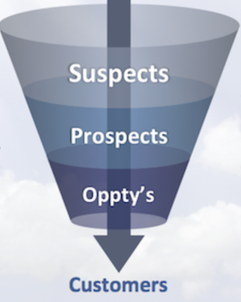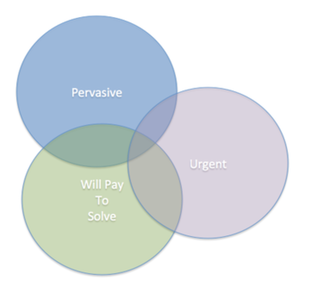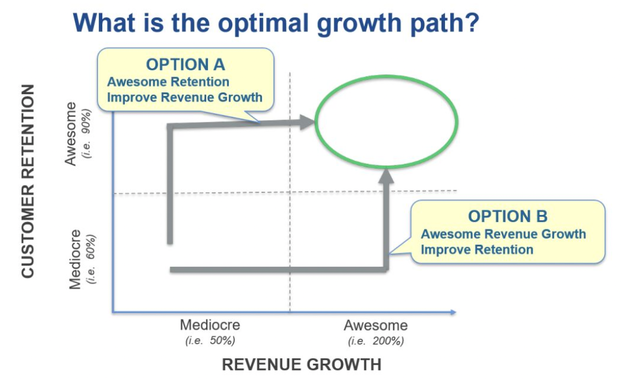|
A marketing and sales funnel has multiple stages:
Tracking your funnel is the single most important analytical tool to planning and visualizing the health of your marketing and sales strategy at any given moment. It’s scandalous how many companies don’t actually talk about the business in terms of their funnel, or only look at certain segments of the funnel (like top-of-funnel "leads"), or simply don't track valid funnel data. Without good visualization of the funnel, you're operating blind! Let’s look at each stage of the funnel and see what kind of growth and conversion principles we can apply. SUSPECTS (TARGET MARKETS, TARGET PERSONAS) Who are the people that can't live without your product? Why is the product a must-have for them? And what is the difference between these must-have users compared to other users for whom it's just a nice-to-have? Start by answering 5 simple questions:
Of course, you need to have the correct answers to those questions, which can only come from primary and secondary market research including talking to real people using product-market fit interviews. For a quick start on how to define and refine your target markets and identify the real personas, see Identify Your "Must-Have" Customers. MARKET SEGMENTATION PITFALLS:
Once you have your targets, now ask - how can I get 100 names of people to reach out directly to?
PROSPECTS (TOP OF FUNNEL) Assuming you found the right Suspects and were able to get in front of them via events, direct marketing, partners, etc. the next question is how do I convert as many to Prospects as possible, ie. get them to reach out and express an interest in buying something. This is done by explaining your offer in a variety of ways: a website that describes that problems you solve and how you solve them, practical advice and expertise delivered via blog, webinar, or podcast, marketing promotions and advertisements, press releases, joint partner marketing, and direct sales. All of these conversion tactics rely on one thing: having compelling content. Most common pitfalls when trying to convert suspects into prospects / MQLs:
If you're a marketing leader, get clear on who in your company is the market expert? Who understands the target personas, their big unsolved problems, what their buying habits are, where they buy, who they consult when making a purchasing decision, what a day-in-the-life of the persona looks like, etc. Is it the product manager? The marketing manager? Sales? The VP? Sometimes you will find that in the day-to-day busy-ness, no one is the marketing expert! That's a problem to tackle head on. If you are the business owner of a startup, then get ready because the market expert is you! You cannot delegate this to marketing. Whatever you do, test all content and messaging that goes out with a lightweight focus group. This step is so critical. This is now a standard in product design, we do ‘usability testing’ before releasing a new product, so why not the same for marketing? Before you roll out a new campaign out to the world – check it with a few friendlies outside of your company who will give an unbiased opinion. OPPORTUNITIES (MIDDLE OF FUNNEL) Marketing often thinks that once the lead is handed off to sales, it’s now sales’ job to convert that lead to an opportunity, and if they are not successful, well they’re just not selling hard enough! Not only is it not collaborative, but it very well could have been that the lead was wrong to begin with and this is something marketing should want to know about so they can refine. Marketing and sales must work together at every stage of the funnel. Another pitfall is thinking that the way to get conversion is to re-arrange your website to drive prospects towards the "sign up" button. But prospects are not helpless. If they are interested, they will find your "sign up" button. So here is the real litmus test. The problem you are solving must be:
Customers won’t pay for something unless it the problem is urgent and they can get sign-off to buy in their fiscal year. Of course, the problem you identify has to be pervasive across a big enough group of customers so that you can build a repeatable business. But most of all, the problem has to be important enough that the person would actually invest their time and money to solve it. People don’t easily part with their money, or their time. They won’t even waste their time browsing your website unless your tagline indicates clear potential of solving a specific problem. They won’t spend time convincing their organization and their CFO to invest unless they are truly motivated to solve something big. If you feel strongly that you are solving the an urgent, pervasive problem, the best way to showcase it is with a demo or free trial. The free trial experience has become a must in the SaaS world, and increasingly an industry standard as it begins providing value right away and allows you to track and gain insight into users' behaviour toward conversion. Look up product-led growth (PLG) to understand more about how to create a world-class free trial that drives conversion. CUSTOMERS This is where things get really interesting. What is your growth strategy with existing customers? Selling something additional to existing customers is the fastest path to revenue. You have a trust relationship there already, you have procurement already in place i.e. contracts, approved vendor list, etc. and you have a captive audience who will tell you all about their problems and what they need and will pay for. Yet many teams are so focused on growing the top of the funnel that they shortchange existing customer growth. Stage 2's Science of Scaling calls it out bluntly: "Startup failure is unnecessarily high due to a premature obsession with top line revenue growth [...] We don’t prioritize customer retention. We are obsessed, almost out of the gate, with revenue growth. And it’s killing our businesses." Paul Graham from Y-combinator emphasizes this further: You should take extraordinary measures not just to acquire users, but also to make them happy. For as long as they could (which turned out to be surprisingly long), Wufoo sent each new user a hand-written thank you note. Your first users should feel that signing up with you was one of the best choices they ever made. And you in turn should be racking your brains to think of new ways to delight them. 10 Things You Can Do Right Now To Improve Customer Retention and Growth:
1 Comment
|



